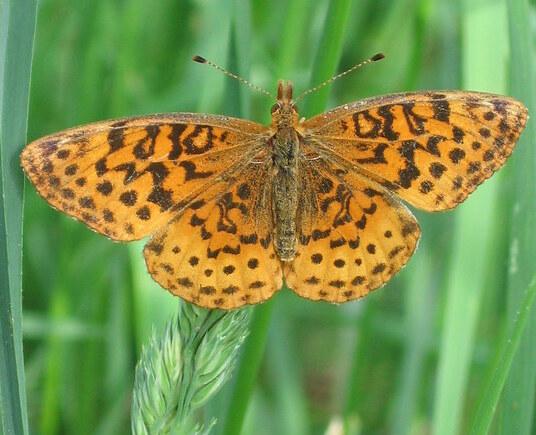Low-
Moderate
The population size of the meadow fritillary (toddi subspecies) in Washington is low and is considered to have a declining trend. This butterfly is recognized as "Species of Greatest Conservation Need" in Washington due to its rare and restricted hostplants and habitat types, small number of isolated populations, limited range and distribution, and known threats to their habitats. Research is especially needed to understand and quantify specific habitat requirements, including vegetation structure, food plant size and density, and key habitat features.
Description and Range
Physical description
The meadow fritillary is in the genus Boloria (lesser fritillaries). It has distinctive black line and dot patterning on its bright orange upperside, and a heavily-patterned underside with muted colored triangles. Wingspan is up to 2 inches. Fritillary larvae are generally dark with many bristled spines.
Ecology and life history
The meadow fritillary (toddi subspecies) inhabits meadows, forest openings, and riparian corridors in aspen and pine woodlands between 2000 to 4500 feet in elevation in northeastern Washington. It is a violet host butterfly, found with the white-flowering Canada violet (Viola canadensis).
Like other lesser fritillaries, the meadow fritillary has two generations per year (spring and late summer). They are sedentary butterflies and do not migrate; instead, the species inhabits sites year-round (as egg, larva, pupa and adult). Adults emerge from their chrysalids (pupae) during both spring and late summer.
Males begin emergence first, followed by females; late season individuals are primarily or solely females. Weather influences butterfly emergence and flight period duration, with wet or cold conditions potentially delaying emergence.
Both males and females feed by using their long proboscis to sip floral nectar.
Male fritillaries seek mates using rapid patrolling and searching flight behavior. Females search for egg-laying sites by slowly flying and hovering above hostplants and then landing and crawling to inspect vegetation before depositing eggs singly.
In Boloria fritillaries, the first (spring) generation of eggs mostly develops quickly, resulting in the second (summer) generation. Larvae from this second generation develop slowly and are the overwintering form for these butterflies. Larvae feed nocturnally on their hostplant; this characteristic, along with bristled spines on their dark body and a gland that secretes defensive chemicals, protects them from predators.
Geographic range
The distribution of the meadow fritillary (toddi subspecies) is limited in part by their dependence on rare habitat types. Their distribution and abundance in Washington is characterized by low numbers of small, isolated populations. Declines in both the number and size of populations have been documented for this species.
Overall, the range of this species encompasses populations in Okanogan highlands and northeastern Washington and in British Columbia, Canada.
In Washington, the species has been detected in the following counties: Ferry, Okanogan, Pend Oreille, and possibly Stevens. Surveys have been conducted to determine the current distribution of the meadow fritillary in the northeastern part of the state. Little is known of the current status and distribution of the species in other portions of their range within the state.
For a map of range-wide distribution and conservation status of the meadow fritillary (toddi subspecies), check out NatureServe Explorer.
Climate vulnerability
Sensitivity to climate change
Low-
Moderate
There is almost no information regarding the sensitivity of this species to climate change, particularly in Washington. Similar to other butterflies, it is likely physiologically sensitive to changes in precipitation and temperature, which may affect larval development and adult behavior. Increasing fire frequency may help maintain and prevent succession of its meadow and forest opening habitat. Riparian habitat may be affected by increasing flood frequencies, as well as fire (see habitat summaries).
Exposure to climate change
Moderate
- Increased temperatures
- Changes in precipitation
- Altered fire regimes
Conservation
Conservation Threats and Actions Needed
- Invasive and other problematic species
- Threat: Invasive plants, those currently here, and many yet to come in the future, out-compete native grassland species, and otherwise make habitat unsuitable.
- Action Needed: Using herbicide, fire, and mechanical methods to restore meadows.
- Threat: Forest encroachment due to long-term fire suppression has reduced the amount and quality of habitat. Hostplant (violet species) is an herbaceous species, and the butterfly occupies open habitat.
- Action Needed: Removed invading trees and shrubs.
- Agricultural and aquacultural side effects
- Threat: Intensive livestock use may cause direct harm to the butterfly through trampling, and indirect harm by reducing host and nectar plant species and compacting soil
- Action Needed: Install fencing to carefully manage or prohibit livestock access to occupied riparian areas
See the Climate vulnerability section for information about the threats posed by climate change to this species.
Resources
References
Boggs, C. 2003. Environmental variation, life histories, and allocation in Butterflies: Ecology and Evolution Taking Flight. Boggs, C., W. Watt, and P. Ehrlich, eds. The University of Chicago Press. 737pp.
James, D. and D. Nunnallee. 2011. Life Histories of Cascadia Butterflies. Oregon State Univ. Press, Corvallis. 447pp.
Pyle, R.M. and C.C. LaBar. 2018. Butterflies of the Pacific Northwest. Timber Press. 461 pp.
Pyle, R. 1989. Washington butterfly conservation status report and plan. WDFW, Olympia. 216pp.
US Forest Service and Bureau of Land Management (USFS-BLM). 2012. Species fact sheet: Meadow Fritillary. Prepared by The Xerces Society for Invertebrate Conservation. Portland, Oregon.
